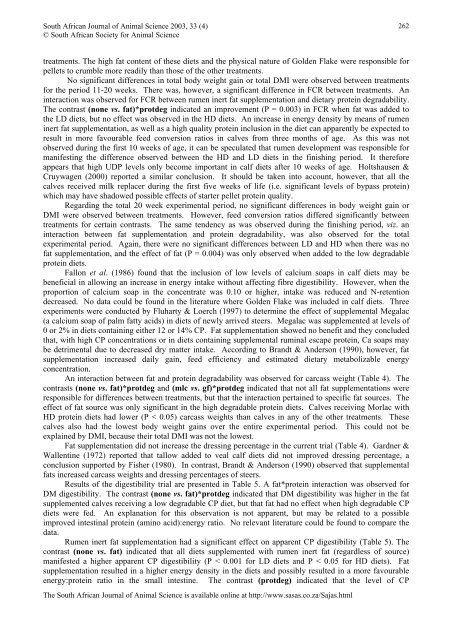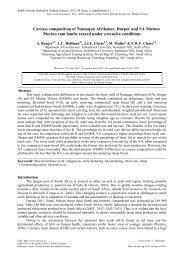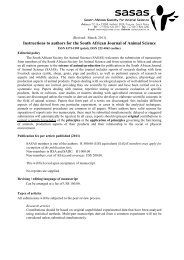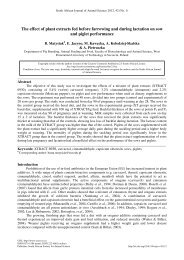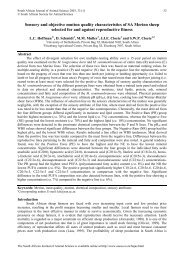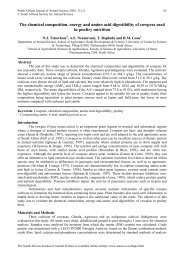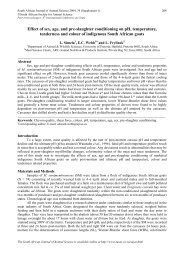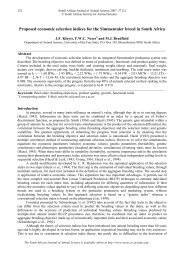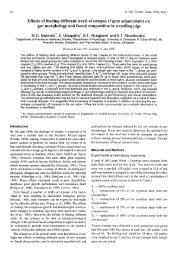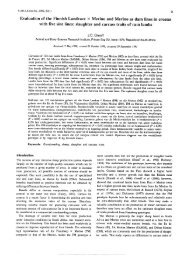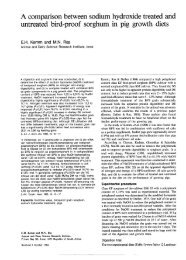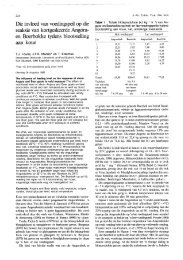The effect of rumen inert fat supplementation and protein - African ...
The effect of rumen inert fat supplementation and protein - African ...
The effect of rumen inert fat supplementation and protein - African ...
You also want an ePaper? Increase the reach of your titles
YUMPU automatically turns print PDFs into web optimized ePapers that Google loves.
South <strong>African</strong> Journal <strong>of</strong> Animal Science 2003, 33 (4)© South <strong>African</strong> Society for Animal Science262treatments. <strong>The</strong> high <strong>fat</strong> content <strong>of</strong> these diets <strong>and</strong> the physical nature <strong>of</strong> Golden Flake were responsible forpellets to crumble more readily than those <strong>of</strong> the other treatments.No significant differences in total body weight gain or total DMI were observed between treatmentsfor the period 11-20 weeks. <strong>The</strong>re was, however, a significant difference in FCR between treatments. Aninteraction was observed for FCR between <strong>rumen</strong> <strong>inert</strong> <strong>fat</strong> <strong>supplementation</strong> <strong>and</strong> dietary <strong>protein</strong> degradability.<strong>The</strong> contrast (none vs. <strong>fat</strong>)*protdeg indicated an improvement (P = 0.003) in FCR when <strong>fat</strong> was added tothe LD diets, but no <strong>effect</strong> was observed in the HD diets. An increase in energy density by means <strong>of</strong> <strong>rumen</strong><strong>inert</strong> <strong>fat</strong> <strong>supplementation</strong>, as well as a high quality <strong>protein</strong> inclusion in the diet can apparently be expected toresult in more favourable feed conversion ratios in calves from three months <strong>of</strong> age. As this was notobserved during the first 10 weeks <strong>of</strong> age, it can be speculated that <strong>rumen</strong> development was responsible formanifesting the difference observed between the HD <strong>and</strong> LD diets in the finishing period. It thereforeappears that high UDP levels only become important in calf diets after 10 weeks <strong>of</strong> age. Holtshausen &Cruywagen (2000) reported a similar conclusion. It should be taken into account, however, that all thecalves received milk replacer during the first five weeks <strong>of</strong> life (i.e. significant levels <strong>of</strong> bypass <strong>protein</strong>)which may have shadowed possible <strong>effect</strong>s <strong>of</strong> starter pellet <strong>protein</strong> quality.Regarding the total 20 week experimental period, no significant differences in body weight gain orDMI were observed between treatments. However, feed conversion ratios differed significantly betweentreatments for certain contrasts. <strong>The</strong> same tendency as was observed during the finishing period, viz. aninteraction between <strong>fat</strong> <strong>supplementation</strong> <strong>and</strong> <strong>protein</strong> degradability, was also observed for the totalexperimental period. Again, there were no significant differences between LD <strong>and</strong> HD when there was n<strong>of</strong>at <strong>supplementation</strong>, <strong>and</strong> the <strong>effect</strong> <strong>of</strong> <strong>fat</strong> (P = 0.004) was only observed when added to the low degradable<strong>protein</strong> diets.Fallon et al. (1986) found that the inclusion <strong>of</strong> low levels <strong>of</strong> calcium soaps in calf diets may bebeneficial in allowing an increase in energy intake without affecting fibre digestibility. However, when theproportion <strong>of</strong> calcium soap in the concentrate was 0.10 or higher, intake was reduced <strong>and</strong> N-retentiondecreased. No data could be found in the literature where Golden Flake was included in calf diets. Threeexperiments were conducted by Fluharty & Loerch (1997) to determine the <strong>effect</strong> <strong>of</strong> supplemental Megalac(a calcium soap <strong>of</strong> palm <strong>fat</strong>ty acids) in diets <strong>of</strong> newly arrived steers. Megalac was supplemented at levels <strong>of</strong>0 or 2% in diets containing either 12 or 14% CP. Fat <strong>supplementation</strong> showed no benefit <strong>and</strong> they concludedthat, with high CP concentrations or in diets containing supplemental ruminal escape <strong>protein</strong>, Ca soaps maybe detrimental due to decreased dry matter intake. According to Br<strong>and</strong>t & Anderson (1990), however, <strong>fat</strong><strong>supplementation</strong> increased daily gain, feed efficiency <strong>and</strong> estimated dietary metabolizable energyconcentration.An interaction between <strong>fat</strong> <strong>and</strong> <strong>protein</strong> degradability was observed for carcass weight (Table 4). <strong>The</strong>contrasts (none vs. <strong>fat</strong>)*protdeg <strong>and</strong> (mlc vs. gf)*protdeg indicated that not all <strong>fat</strong> <strong>supplementation</strong>s wereresponsible for differences between treatments, but that the interaction pertained to specific <strong>fat</strong> sources. <strong>The</strong><strong>effect</strong> <strong>of</strong> <strong>fat</strong> source was only significant in the high degradable <strong>protein</strong> diets. Calves receiving Morlac withHD <strong>protein</strong> diets had lower (P < 0.05) carcass weights than calves in any <strong>of</strong> the other treatments. <strong>The</strong>secalves also had the lowest body weight gains over the entire experimental period. This could not beexplained by DMI, because their total DMI was not the lowest.Fat <strong>supplementation</strong> did not increase the dressing percentage in the current trial (Table 4). Gardner &Wallentine (1972) reported that tallow added to veal calf diets did not improved dressing percentage, aconclusion supported by Fisher (1980). In contrast, Br<strong>and</strong>t & Anderson (1990) observed that supplemental<strong>fat</strong>s increased carcass weights <strong>and</strong> dressing percentages <strong>of</strong> steers.Results <strong>of</strong> the digestibility trial are presented in Table 5. A <strong>fat</strong>*<strong>protein</strong> interaction was observed forDM digestibility. <strong>The</strong> contrast (none vs. <strong>fat</strong>)*protdeg indicated that DM digestibility was higher in the <strong>fat</strong>supplemented calves receiving a low degradable CP diet, but that <strong>fat</strong> had no <strong>effect</strong> when high degradable CPdiets were fed. An explanation for this observation is not apparent, but may be related to a possibleimproved intestinal <strong>protein</strong> (amino acid):energy ratio. No relevant literature could be found to compare thedata.Rumen <strong>inert</strong> <strong>fat</strong> <strong>supplementation</strong> had a significant <strong>effect</strong> on apparent CP digestibility (Table 5). <strong>The</strong>contrast (none vs. <strong>fat</strong>) indicated that all diets supplemented with <strong>rumen</strong> <strong>inert</strong> <strong>fat</strong> (regardless <strong>of</strong> source)manifested a higher apparent CP digestibility (P < 0.001 for LD diets <strong>and</strong> P < 0.05 for HD diets). Fat<strong>supplementation</strong> resulted in a higher energy density in the diets <strong>and</strong> possibly resulted in a more favourableenergy:<strong>protein</strong> ratio in the small intestine. <strong>The</strong> contrast (protdeg) indicated that the level <strong>of</strong> CP<strong>The</strong> South <strong>African</strong> Journal <strong>of</strong> Animal Science is available online at http://www.sasas.co.za/Sajas.html


